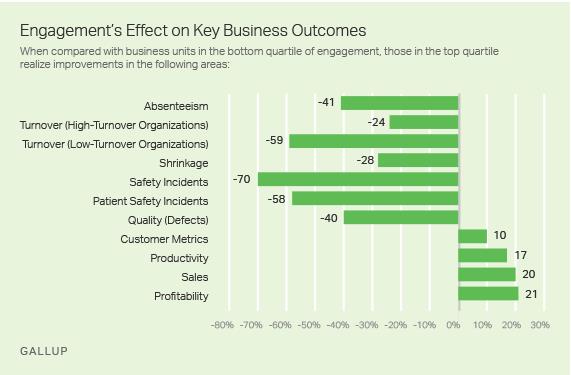Blog
How to Build a Winning Culture With High Employee Engagement
4/13/2018 5:00:00 AM

This article was originally featured on Money Inc.
“What makes a business grow?” is a question with many answers: marketing, management, logistics, market intelligence, and countless other factors contribute to overall success. However, there is another factor almost all companies rely on for long-term success, regardless of the industry and company size: Productive employees. Such employees don’t just materialize out of thin air -- they become engaged through a company culture that is cohesive, encouraging, and motivating.
Surprisingly enough, this cornerstone business strategy can be easily overlooked in lieu of other, seemingly more important tasks, such as sales, marketing, or customer outreach. However, ignoring the cultivation of employee engagement can cost companies valuable profits and growth -- important assets that could be realized with a strong company culture.
Here we’ll explore how investing in employee engagement can be one of the most cost-effective strategies for improving overall productivity, profits, and customer satisfaction.
The Core of Employee Engagement: Embracing Change
Employee engagement isn’t just about fostering a workplace culture that encourages positive attitudes and behaviors -- it’s also about embracing change. A true winning culture will evolve and adapt as a company grows. Employees and employers alike must be collaborative and possess an openness to change. No growing company will be the same as it was on day one, and one of the biggest follies a company can make is to maintain the idea: “Well, this is how we’ve always done it,” or, “If it ain’t broke, don’t fix it.” Progress equals growth, and for a business to be able to make the best decisions that drive profitability, they must be able to embrace change.
A winning company culture isn’t just giving employees occasional perks such a free quarterly lunch or an annual holiday bonus. And it also doesn’t mean that all employees are happy all of the time. Work is still work -- by definition, it’s not a place to play. A winning culture is when both employees and employers share the same values and desire successful business outcomes. A winning culture seeks to cultivate employees who are motivated, supported, engaged, and passionate about their craft. Employee engagement makes for loyal employees who are proud of the work they do and eager to do the best job possible. They see their work as valuable and meaningful, and it often sees these employees realize potential beyond what anyone may have imagined in areas like productivity, creativity, and diligence.
Why Invest in Culture Engagement?
In short, you probably can’t afford not to. According to research by Gallup, as few as 13% of employees worldwide are engaged at work, and just 33% of American employees are engaged at work. These low numbers become more important (and apparent) when you realize what they mean — low employee-engagement numbers mean decreases in quality, productivity, customer ratings, and profitability, along with increases in turnover, workplace accidents, absenteeism, and shrinkage.

Businesses with high employee engagement consistently earn more, and the differences can be huge. A separate Gallup report indicates that companies can expect up to 18% higher revenue and 15% more productivity per engaged employee, as well as increases in customer satisfaction of up to 30%. Couple this with the knowledge that just a 10% increase in investment toward employee engagement can increase profits by over $2,000 per year, per employee, and it’s difficult to deny the impact of engagement in the workforce.
Lastly, employee engagement produces short-term gains that are easy to see at the end of every quarter but also helps build long-term assurance for your success through employee retention. Engaged, motivated, and productive employees are much more likely to stay with your company. According to Demand Metric, organizations that have over 50% employee engagement retain over 80% of their customers. This indicates that a combination of satisfied customers and loyal employees can help your business weather market uncertainty and stay ahead of the competition.
How to Increase Employee Engagement
There are many ways to increase employee engagement, and here we’ll focus on a few of the more fundamental aspects of how to do this. These three tips are things all organizations should be doing to encourage success, and those who do them well will rise to the top.
Know Your Company’s Purpose and Share It
One way, but not the only way, for a company to generate employee buy-in with your culture is with a mission statement that inspires them. Many of the world’s most successful companies rely heavily on a clear statement of values to inspire both employees and customers alike to have faith in their brands. With this in mind, it’s easy to see why companies like Google, Zappos, and Whole Foods put values and mission front-and-center when building employee engagement.
Of course, values won’t engage employees if it’s just a static list -- employees needs to feel personally connected to them in order to feel vested in the company. Moreover, a mission-statement need not be this long. It could simply be something like wanting to exude an entrepreneurial spirit. Finally, a young company needs to understand that its business will evolve and so may its mission statement. There is no need to prematurely draft such a statement until you are ready.
Cultivate Employees’ Personal Growth
Your employees are capital, and it makes good sense to grow your capital. Like all gains, this requires investment, but investment is vital in finding and retaining the most engaged and talented employees. The modern workplace cannot be boring or stagnant if you wish to keep the most ambitious and innovative of your employees from seeking more-fulfilling opportunities. There are some things you can do that don’t cost much and yield great returns — like allowing employees the freedom to work on projects they’re passionate about (like Hubspot).
Empowering your employees with decision-making opportunities can also be huge for employee engagement. Companies like Warby Parker have seen better results with this approach. Instead of simply handing over management to employees, Warby Parker blends the traditional structures of management with self-management. As noted by Harvard professor Bernstein, “the execution is self-organized, but the organization is not.” As a manager, you could view this approach as coaching, rather than managing. You are empowering your team with the authority and the tools they need to do their jobs well (without micromanaging), but you’re staying accessible and available as they complete these tasks.
Create Well-Defined Roles for Your Employees
Few things are as demoralizing to an employee as feeling their work is meaningless. Creating well-defined roles (and goals) is the best way to prevent this from happening. It’s crucial to a company’s culture that employees can readily see the impact they have on success of the organization as a whole. This concern for clearly-defined roles permeates the cultures of the most successful businesses, and it starts at the very top. From corporate to management, to each department, team, and individual employee, these cultures foster a sense of purpose and belonging that helps ensure you get the best efforts of the best people, year in and year out.
For those people who do not seem to “fit” in their given role it is important to try to find them a better seat on the bus if you can. However, don’t be afraid for people to leave the company if they do not adhere to your core values, i.e. not everyone hired will be a culture fit.
Final Thoughts
Employees who consistently do the best work possible with your company’s best interests at heart are engaged employees — they are loyal hardworking, and committed to excellence. These values come from the top-down. They come from interested managers and the commitment to investing in both the business and the team members it depends upon.
Request a Proposal
If you are interested in any of our services, you can request a proposal by filling out the fields in this section.
CONTACT US
- Case Inquiry
- Media Contact
- 1-800-207-7160
- info@JNDLA.com
- www.JNDLA.com
- Careers@JNDLA.com
JOIN US